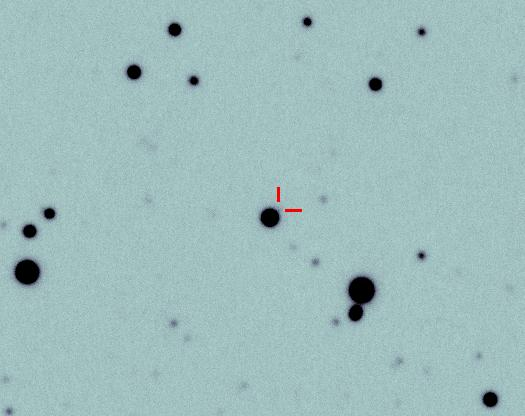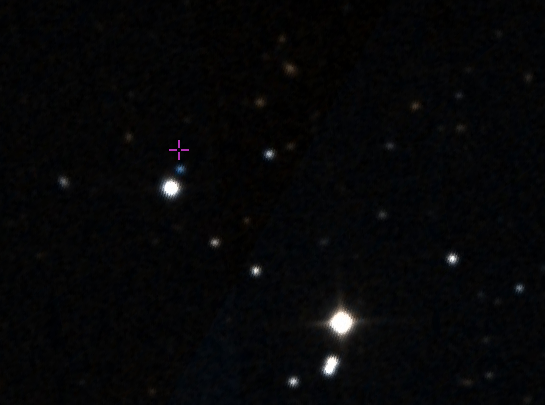Forum Replies Created
-
AuthorPosts
-
 Dr Paul LeylandParticipant
Dr Paul LeylandParticipantHave you tried putting a hub between the laptop and the camera?
26 August 2020 at 3:19 pm in reply to: Paper includes supernova classified using the ALPY200 #583047 Dr Paul LeylandParticipant
Dr Paul LeylandParticipant“But for the amateur discovery and initial classification of SN 2018gwo, it might have been missed.”
Nice one Robin.
 Dr Paul LeylandParticipant
Dr Paul LeylandParticipanthttps://tvlapalma.com/not/18598/incendio-palma-continua-estabilizado-vecinos-evacuados-aun-no/ has a good report and an aerial view showing the burnt area and (apparent) lack of active fires. It explains that evacuees can not return until the authorities are certain the fire will not start up again.
If you don’t read Spanish, Google Translate will come to your aid.
 Dr Paul LeylandParticipant
Dr Paul LeylandParticipantThe fire is mostly under control, though there are still some hot spots that need attention.
A major problem has been the weather. About 20% humidity, winds up to 50km/hour and temperatures up to 35C.
Last night I opened up the observatory and took some images. The dome temperature never fell below 20C and the wind-induced seeing was about 6 to 7 arcseconds. No good for pretty pictures but photometry was possible, albeit at the cost of markedly increased exposure times.
Wind is really howling now …
 Dr Paul LeylandParticipant
Dr Paul LeylandParticipantTo be fair to Python (which is hard for me because I have a profound dislike of the language) the various point releases (e.g. 3.7 versus 3.8) appear to be very backward compatible. Something written for 3.7 will almost certainly run without any issues on 3.8 and, when it arrives, 3.9. Problems can arise in the other direction but old code tends to run well.
The real problems arose when Python 2.x reached end of life earlier this year. Vast amounts of code is now on emergency life support with kludged-together installations of Python 2. Much more is unavailable. To give just one example, my favourite GUI network scanner, zenmap, is no longer part of the Linux systems I run.
 Dr Paul LeylandParticipant
Dr Paul LeylandParticipantSo do I. The calimas around here have been dreadful recently. Last night had noticeably better seeing but poor transparency. Saharan dust and a full moon are not conducive to good imaging. Some more data was taken, down to an altitude of 20 degrees this time, but my expectations are not high.
 Dr Paul LeylandParticipant
Dr Paul LeylandParticipantIt is many years since I last had contact with Graeme. We used to see each other moderately often when we both worked at Oxford University.
Any chance that you could pass on my contact details to him please?
 Dr Paul LeylandParticipant
Dr Paul LeylandParticipantIndeed. A comet in an orbit with eccentricity of 0.99999 has a large but finite period. One with an eccentricity of 1.00001 has infinite period in that (pending a gravitational interaction with some other body) it will never return to the inner solar system.
 Dr Paul LeylandParticipant
Dr Paul LeylandParticipantAs expected, the image is not very good. The 19 minute exposure in ~5 arcsec FWHM seeing was not long enough for an 18.4 magnitude object only 15 arcsec from a star six magnitudes brighter.
The position of the WD is marked, the star is just about visible but not obvious. For comparison a snippet of the DSS2 image is included. The fainter (north-easternmost) star between the two brightest is mag 17.8 in Gaia DR2. The poor seeing is especially well demonstrated by the inability to resolve the ~6 arcsec double which is visible in the DSS2 image.


I will try again with a longer exposure in much better seeing conditions before uploading to my personal web page.
 Dr Paul LeylandParticipant
Dr Paul LeylandParticipantTonight was the first session of this stay in La Palma. I imaged the field and there is something there but the WD is rather drowned out by the bright star.
Not a very good night with some moon-lit haze and high winds, which makes for poor seeing at this site. The relatively low altitude of the star (30-33 degrees tonight) at this latitude most certainly does not help.
I will process the data tomorrow and see whether there is anything worth posting.
 Dr Paul LeylandParticipant
Dr Paul LeylandParticipantNow that I´m back in Tacande I’ve been able to see the comet for the first time. In the UK I had an obstructed northern sky which is brightly lit by Cambridge city. Here (at latitude 28 degrees north) UMa sets behind the mountains around midnight or so but was well above the horizon at about 2100 local time (circa 18:45 UTC).
The comet was an easy naked-eye object. I guesstimated a roughly 3-degree tail when viewed through 7x50B. The sky was slightly hazy so perhaps more could have been seen under ideal conditions.
Far too big for me to photograph much more than the coma, so I won’t even try.
 Dr Paul LeylandParticipant
Dr Paul LeylandParticipantSDSS 124043.01+671034.68 is relatively bright at Gaia g=18.44 so I’ll see whether I can take an image when I’m back at my observatory in a week or so. There is a g=12.68 star 15 arcsec distant and I hope that the scattered light from it won’t cause too many problems.
Watch this space.
 Dr Paul LeylandParticipant
Dr Paul LeylandParticipantMy real name is Paul Leyland but I’ve been using the pseudonym for many years now.
The reason is quite simple: there are many ‘Paul Leyland’s on the net but only one Xilman as far as I know. Searching on my pseudonym is almost guaranteed to find only me. Searching on my real name is likely to turn up several false positives.
 Dr Paul LeylandParticipant
Dr Paul LeylandParticipantRoger has put together an excellent issue, well worth reading even if you do not plan to do any active observing of exoplanets. That said …
One of the links in Infinite Worlds is https://arxiv.org/abs/2003.09046 which points to a paper entitled Telescopes Operated by Citizen Scientists for Transiting Exoplanet Follow-up where the BAA gets a name check. The exciting take-home message from this paper is that amateurs can perform genuinely important original research and save professional astronomers, using both ground-based and satellite facilities, quite literally years of their scarce and expensive telescope time. Even better, telescopes with apertures of 15cm or so are easily capable of contributing to this effort. (Bigger ones can do more, of course, but they are not essential.)
I urge all BAA members capable of imaging the sky to seriously consider spending a portion of their observing time to help out. The efforts need not be full-time as even a few sporadic sessions form a valuable contribution.
Unfortunately the PDF of that paper is just a little too big to attach to this post uncompressed, and the forum doesn’t allow for files with extensions such as “.z” or “.zip”. Accordingly, I created a ZIP file which squeaks under the limit and renamed it with a .fits extension. If you wish to read the paper, please download the file, then rename it to be named “smallscope_exoplanet.pdf.zip” and finally unzip it with whatever archive program you generally use.
 Dr Paul LeylandParticipant
Dr Paul LeylandParticipantThere are two approaches, one potentially of zero additional cost.
If you are going to be using a colour camera, a typical DSLR for instance, it already comes with a set of three filters — one each for red, green and blue. None of these are standard photometric filters but it is possible to make usefully accurate estimates of what the intensity would have been in standard bands such as Johnson-V. The process takes far too many words to explain here but comprehensive instructions are available on-line. I don’t have URLs immediately to hand but can dig out the references later if you want them (and if you haven’t found them independently).
If you have a mono camera and/or wish to purchase a filter to begin your research-quality observation program, I would recommend buying a Johnson-V filter. They are available from a number of suppliers but please be careful to buy a Johnson-V photometric filter. Supplier’s product listings can be confusing at times.
In the case of DSLR (and other colour) cameras, always download your images in RAW format. Conversion to JPG or whatever will destroy the accuracy of your data. If you are using a filter as well, post-process the images first to separate out the RGB components and then sum or average (not median) combine them to produce a grey-scale image for subsequent analysis.
If you have a colour camera then I would personally use it as-is to learn the basics of the trade before spending more money. But, then, I’m a cheapskate. You are going to have to educate yourself anyway …
 Dr Paul LeylandParticipant
Dr Paul LeylandParticipantIt’s not the size that is important, it’s how you use it.
You can do accurate photometry with telescopes of almost any aperture. The only thing that increased aperture buys you is a fainter limiting magnitude for a given exposure time.
People do precision photometry with nothing more than a DSLR and a standard lens. It is rare for the aperture of such a system to exceed 50mm, or half that of your telescope.
 Dr Paul LeylandParticipant
Dr Paul LeylandParticipantPersonally I use MaximDL but that is an expensive option.
 Dr Paul LeylandParticipant
Dr Paul LeylandParticipantsim is the LaTeX markup for the ~character. Likewise % for %, because % has a mark-up meaning in LaTeX.
 Dr Paul LeylandParticipant
Dr Paul LeylandParticipantIt happens. Several times to me in my career as a sysadmin. Thankfully you know the golden rule: always have a backup available for when (not if) things go pear shaped, as they will do occasionally.
Thanks for all your hard work.
 Dr Paul LeylandParticipant
Dr Paul LeylandParticipant“this morning at about 14.25 BST.”
I hope you mean 04:25 BST, or dawn comes remarkably late where you live 😉
-
AuthorPosts
